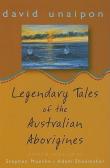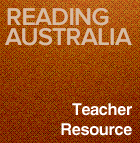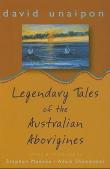AustLit
Latest Issues
AbstractHistoryArchive Description
Originally written in the 1920s by David Unaipon. The original work was edited by W. Ramsay Smith and published in 1930 credited to W. Ramsay Smith as Myths & Legends of the Australian Aboriginals, without acknowledgement of Unaipon's authorship. Shoemaker and Muecke republished it in 2001 under Unaipon's name and original title.
AustLit uses the original Unaipon title as the main title showing Ramsay Smith's title as an alternative title on those editions published prior to the restitution edition.
Reading Australia
This work has Reading Australia teaching resources.
Unit Suitable For
AC: Year 10 (NSW Stage 5). Possibly an extension Year 9 class.
Themes
Aboriginality, Australia, Australian identity, Christianity, Indigenous, Myths and Legends
General Capabilities
Critical and creative thinking, Ethical understanding, Intercultural understanding, Literacy
Cross-curriculum Priorities
Aboriginal and Torres Strait Islander histories and cultures, Sustainability
Notes
-
Originally written in the 1920s by David Unaipon. The original work was edited by W. Ramsay Smith and published in 1930 credited to W. Ramsay Smith as Myths & Legends of the Australian Aboriginals, without acknowledgement of Unaipon's authorship. Shoemaker and Muecke republished it in 2001 under Unaipon's name and original title.
AustLit uses the original Unaipon title as the main title showing Ramsay Smith's title as an alternative title on those editions published prior to the restitution edition.
Contents
- Introduction : Repatriating the Story, single work non-fiction correspondence (p. xi-xliii)
- Note on the Edition, single work review (p. xlv-xlvi)
- Preface, single work prose (p. 3)
- Aboriginal Folklore, single work oral history (p. 4)
- Aborigines, Their Traditions and Customs : Where Did They Come From?, single work oral history (p. 5-7)
- Some Stories About My Race : What the Aborigines' Carvings Near Sydney Mean, single work oral history (p. 8-10)
- Belief of the Aborigine in a Great Spirit, single work oral history (p. 11-13)
- Confusion of Tongue, single work oral history (p. 14-16)
- Fishing, single work oral history (p. 17-24)
- The Flood and its Result, David Unaipon , single work prose dreaming story (p. 25-41)
-
The Gherawhar (Goanna),
David Unaipon
,
single work
prose
dreaming story
(p. 42-52)
'This is a story belonging to the Murrumbidgee River tribe, and they associate this locality as the first settled home of the Gherawhar (Goanna...) after leaving their temporary home at Shoalhaven, and before...to other parts of Australia. When they occupied this country there was no flowing Murrumbidgee River. The only river then was the... which was formed by the ancient Pendie, a fish commonly called the Murray Cod.' (David Unaipon, 1924-25)
-
Gool Lun Naga (Green Frog),
single work
short story
Indigenous story
(p. 53-59)
Benjamin Miller describes this story in the following way: 'a creation story about a Water Spirit who desires to enter the material world. A Lyre Bird, who is adept at singing the songs of other animals, is asked by a spirit to sing into a stream. After much beautiful singing a Being emerges from the water. The Lyre Bird names the Being "Gool lun naga, a son of the clear running stream of water"'.
Source: Benjamin Miller, 'David Unaipon's Style of Subversion: Performativity and Becoming in "Gool Lun Naga (Green Frog)"', JASAL Special Issue (2008):84.
-
Hunting,
single work
oral history
essay
(p. 60-68)
The author talks about the hunting practices of the Australian Aboriginals.
-
How the Tortoise Got His Shell,
David Unaipon
,
single work
prose
dreaming story
(p. 69-70)
A story about the tortoise and his conflict with the Eaglehawk.
-
Immortality,
David Unaipon
,
single work
prose
dreaming story
(p. 71-73)
The author talks about the how the Australian Aboriginals have a legend that explains natural phenomena.
-
Love Story of the Mar Rallang,
single work
prose
dreaming story
(p. 74-76)
The story of two sisters who fall in love with the same boy.
-
The Mar Kar Ree (Moon),
David Unaipon
,
single work
prose
dreaming story
(p. 77-79)
The story of a man called The Mar Kar Ree and his trail of looking for a wife.
-
Marriage Customs of the Australian Aborigines,
single work
oral history
(p. 80-84)
The author talks about the customs,rituals, and laws of marriage between men and women in Australian Aboriginal societies.
-
The Mischievous Crow and the Good He Did,
David Unaipon
,
single work
prose
dreaming story
(p. 85-119)
In a comparison to the biblical stories of the forces of good and evil, the author presents this story of crow from the Narrinyur people, an Aboriginal representation of good and evil which has played an important part in their traditions and legends.
-
Narroondarie's Wives,
single work
short story
(p. 120-133)
'Narroondarie is the name of one of the many good men that were sent among the various tribes of the Australian Aborigines...' (David Unaipon, 1924-25)
Publication Details of Only Known VersionEarliest 2 Known Versions of
Works about this Work
-
Kurangk/Coorong Atmospheres : Postcolonial Stories and Regional Futures
2019
single work
criticism
— Appears in: TEXT : The Journal of the Australian Association of Writing Programs , October vol. 23 no. 2 2019; 'This paper proposes an atmospheric understanding of regional writing, and considers a critical methodology for assembling a literary history of the Kurangk/Coorong region of South Australia. In opposition to literary history guided by national forms, this methodology works from within the shifting entanglements of postcolonial place and its many stories, recognising the material impacts of poetic practice on more-than-human environments. The future of the Kurangk/Coorong is caught up in how this place has, and continues to be, imagined and narrated.' (Publication abstract)
-
Writing Indigenous Vampires : Aboriginal Gothic or Aboriginal Fantastic?
2014
single work
criticism
— Appears in: M/C Journal , August vol. 17 no. 4 2014; 'The usual postmodern suspicions about diligently deciphering authorial intent or stridently seeking fixed meaning/s and/or binary distinctions in an artistic work aside, this self-indulgent essay pushes the boundaries regarding normative academic research, for it focusses on my own (minimally celebrated) published creative writing’s status as a literary innovation. Dedicated to illuminating some of the less common denominators at play in Australian horror, my paper recalls the creative writing process involved when I set upon the (arrogant?) goal of creating a new genre of creative writing: that of the ‘Aboriginal Fantastic’. I compare my work to the literary output of a small but significant group (2.5% of the population), of which I am a member: Aboriginal Australians. I narrow my focus even further by examining that creative writing known as Aboriginal horror. And I reduce the sample size of my study to an exceptionally small number by restricting my view to one type of Aboriginal horror literature only: the Aboriginal vampire novel, a genre to which I have contributed professionally with the 2011 paperback and 2012 e-book publication of That Blackfella Bloodsucka Dance! However, as this paper hopefully demonstrates, and despite what may be interpreted by some cynical commentators as the faux sincerity of my taxonomic fervour, Aboriginal horror is a genre noteworthy for its instability and worthy of further academic interrogation.' (Introduction) -
[Essay] Legendary Tales of the Australian Aborigines
2013
single work
essay
— Appears in: Reading Australia 2013-;'David Unaipon’s Legendary Tales of the Australian Aborigines is part of the classical culture of Australia. The collection is as varied in subject as it is ambitious in scope, ranging from ethnographic essays on sport, hunting, fishing and witchcraft to the legends of ancestral beings who transformed the landscape in the Dreaming. The stories are unified by the voice of Unaipon, Australia’s first Indigenous author, whose familiar face now adorns the fifty dollar note.' (Introduction)
-
Aboriginal Literature in Austria: A Discussion of Three Audiobooks
2011
single work
criticism
— Appears in: Australian Aboriginal Studies , no. 1 2011; (p. 51-64)'The author discusses the overseas marketing of translated Aboriginal literature which has received scant scholarly attention. The paper examines three examples of Aboriginal literature that have been translated into German and produced as audiobooks by two Austrian publishers...this paper focuses on the translation and promotion of these audiobooks by their Austrian publishers and argues that an understanding of the representation of Aboriginal people in these audiobooks is informed by different aspects of translation and advertisement as well as the format of the medium itself' (Source: Abstract).
-
Black and White : In Search of an ‘Apt’ Response to Indigenous Writing
2010
single work
criticism
— Appears in: TEXT : The Journal of the Australian Association of Writing Programs , October vol. 14 no. 2 2010; 'The good editor,' suggests Thomas McCormack in his Fiction Editor, the Novel and the Novelist, 'reads, and ... responds aptly' to the writer's work, 'where "aptly" means "as the ideal appropriate reader would".' McCormack develops an argument that encompasses the dual ideas of sensibility and craft as essential characteristics of the fiction editor. But at an historical juncture that has seen increasing interest in the publication of Indigenous writing, and when Indigenous writers themselves may envisage a multiplicity of readers (writing, for instance, for family and community, and to educate a wider white audience), who is the 'ideal appropriate reader' for the literary works of the current generation of Australian Indigenous writers? And what should the work of this 'good editor' be when engaging with the text of an Indigenous writer? This paper examines such questions using the work of Margaret McDonell and Jennifer Jones, among others, to explore ways in which non-Indigenous editors may apply aspects of McCormack's 'apt response' to the editing of Indigenous texts.' (Author's abstract)
-
In Pursuit of Rightful Custodians
2002
single work
review
— Appears in: The Times Literary Supplement , 21 June no. 5177 2002; (p. 28)
— Review of Legendary Tales of the Australian Aborigines 1924 selected work prose -
Untitled
2002
single work
review
— Appears in: Reading Time : The Journal of the Children's Book Council of Australia , February vol. 46 no. 1 2002; (p. 35-36)
— Review of Legendary Tales of the Australian Aborigines 1924 selected work prose -
The Legendary David Unaipon
2002
single work
review
— Appears in: Cultural Studies Review , May vol. 8 no. 1 2002; (p. 176-179)
— Review of Legendary Tales of the Australian Aborigines 1924 selected work prose -
Blak and Write
2006
single work
review
— Appears in: The Bulletin , 12 September vol. 124 no. 6537 2006; (p. 68-69)
— Review of Legendary Tales of the Australian Aborigines 1924 selected work prose ; Meanjin vol. 65 no. 1 2006 periodical issue ; Rob Riley : An Aboriginal Leader's Quest for Justice 2006 single work biography -
Mythical Book Rights a Literary Wrong
2006
single work
review
— Appears in: The Courier-Mail , 20 - 21 May 2006; (p. 27)
— Review of Legendary Tales of the Australian Aborigines 1924 selected work prose -
Introducing David Unaipon
2003
single work
criticism
— Appears in: The Regenerative Spirit : Volume 1 : Polarities of Home and Away, Encounters and Diasporas, in Post-Colonial Literatures 2003; (p. 6-13) -
A Summary of the Best New Books
1930
single work
column
— Appears in: All About Books , 5 December vol. 2 no. 12 1930; (p. 325-329) This column is written 'as a bookseller selecting books for different types of readers rather than as a literary critic'. It is divided into the sections: 'Novels of Literary Merit', 'Popular Good Stories' and 'General Literature'. Its emphasis is not Australian literature. -
Australian Children's Books
1926
single work
column
— Appears in: The Australian Woman's Mirror , 9 November vol. 2 no. 50 1926; (p. 18) -
Introduction : Repatriating the Story
2001
single work
non-fiction
correspondence
— Appears in: Legendary Tales of the Australian Aborigines 2001; (p. xi-xliii) -
Note on the Edition
2001
single work
review
— Appears in: Legendary Tales of the Australian Aborigines 2001; (p. xlv-xlvi)
- Australian animals
- Aboriginal law
- Aboriginal religion & stories
- Creation myths & beliefs
- Meetings
- Mythical & magical creatures
- Aboriginal hunting, gathering & fishing
- Spiritual & religious beliefs
- Murray River
- Animal behaviour
- Morality
- Aboriginal relationship with the land
- Aboriginal culture
- Sharing
- Knowledge







